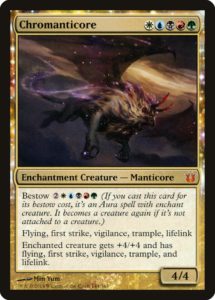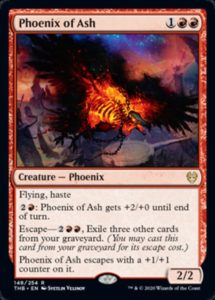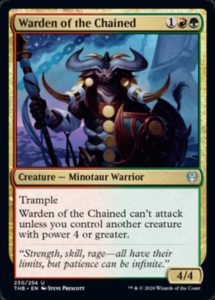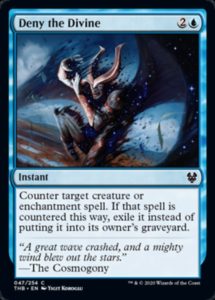Prerelease is in the rear-view mirror, and both release weekend and MagicFest New Jersey loom large. I managed to get in several paper and Magic Online drafts over the weekend; and while the format certainly isn’t solved, much of it has come into at least blurry focus.
The Colors
As basically everyone expected, black seems the premier color. It boasts three incredibly powerful common removal spells, a solid creature base, and multiple ways to both shut off Escape and negate the format’s many bombs. Green also looks to be quite strong, with Return to Nature and Warbriar Blessing providing solid interaction while Loathsome Chimera and Voracious Typhon serve as recursive threats.
In initial testing, white has come up a bit short, since Constellation and Devotion are lacking common payoffs. Red benefits from two powerful common removal spells but suffers from mostly anemic and aggressive creatures (familiar territory for the color). The big outstanding question is just how good blue is: as in Throne of Eldraine, it has excellent card advantage and disruption (Deny the Divine can stop almost every bomb in the format) but mostly anemic creatures.
It’s too early to say just how much better some colors are than others. If we set aside bombs, I’d expect to see a lot of black and black-green decks this weekend at GP Jersey. But that brings us to the elephant in the room.
Mythic Power with Uncommon Frequency
There are a lot of bomb rares in Theros Beyond Death. Not just mythics—rares. Moreover, many of them are more akin to Bonecrusher Giant, Lochmere Serpent, and Wicked Wolf than they are Irencrag Pyromancer, Lovestruck Beast, and Worthy Knight. Many of them are cheap threats that provide card advantage, quickly take over the game, and/or require minimal effort.
Nadir Kraken, Aphemia, the Cacophany, Nightmare Shepherd, Woe Strider, Phoenix of Ash, The Akroan War, and Dream Trawler are absolutely bonkers, with Archon of Sun’s Grace, Elspeth Conquers Death, Heliod’s Intervention, Thryx, the Sudden Storm, and Sestessan Champion being merely insane rares. That’s 12/53 rares or just under a quarter, and many of the others are no slouch (while some of them are, as ever, awful or mediocre in Limited).
This means you’ll need tools to deal with them, especially in Sealed, but they’re numerous enough you should expect to face them in draft. You’ll want to sequence your removal carefully; sometimes you need Mire’s Grasp immediately to shut down a Nadir Kraken before it grows out of range, a Final Death to exile a Phoenix of Ash, or a Mystic Repeal to bottom a god. Deny the Divine is clean answer to almost everything (except for Destiny Spinner or a Thryx, the Sudden Storm in play) and has repeatedly overperformed.
Dream Trawler is one of the more powerful and unstoppable bombs in the set, but it’s vulnerable to Rise to Glory or Flicker of Fate—when auras like Dreadful Apathy return to the battlefield, they don’t target and can circumvent Hexproof. It’s unfortunate when obscure interactions are some of the only answers to bombs, but try to find these angles where you can.
Weak, Combination Themes
There’s an awkwardness to THB Limited due to how its mechanics are designed. Almost all its mechanics are A+B mechanics, where you need to combine cards with different qualities for them to function. Constellation is only on non-enchantment creatures but requires a density of enchantments. Heroic requires a wide battlefield and combat tracks or auras to trigger a Battle Cry, but there are neither Bestow creatures nor Fists of Ironwood to play double duty. UR flash-matters, RG Ferocious, and BR sacrifice all follow the same principle, with Ferocious having the easiest time (a single 4+ power creature keeps the mechanic enabled as long as it lives) while Constellation, Heroic, and flash-matters need a steady stream of triggers. Even Devotion and Escape follow this rule, though they’re far more flexible (but still requiring some enabling).
These mechanics generally require different inputs and provide disparate outputs (so they don’t feel or play the same), but the method is the same: combine two different kinds of things to make them more than the sum of their parts. This puts heightened demand on one’s ability to smooth out draws. A lack of card flow means that players are more at the mercy of the top twelve or so cards of their deck, where luck and mulligans have an outsize effect on the game.
The cycle of Omens are pretty brilliantly designed glue for the set, since they enable Constellation, Devotion, flash, sacrifice, and Escape, all while providing an incredibly useful Scry 2 to find the piece you need. The problem is that there’s almost nothing else to sift through your deck (unless you’re playing blue). Scry is only on seven other commons, and Inspire Awe, Portent of Betrayal, and Rumbling Sentry aren’t doing much to sculpt an early game. A small amount of Scry probably isn’t enough to help nonblue mages find what they need, and this coupled with the lack of mana sink mechanics like Bestow or Monstrosity (Escape plays in this space, but is unequally distributed throughout the colors) means the format runs the risk of feeling very random.
Many of Theros’ mechanics provide both few and often anemic payoffs—outside of Wavebreak Hippocamp, blue-red’s best payoff is getting to play at instant speed, not working really, really hard to make Arena Trickster into a 6/6. Perhaps this undercuts the need for more card flow, since the interactions aren’t that powerful, but this exacerbates the issue of pervasive bomb rares that laugh in the face of mini synergies.
The Big Picture
It’s still very, very early for Theros Beyond Death. The set has a lot of nuance to it and my initial fears that its monocolor theme and focus on deckbuilding would make it too similar to Eldraine seem unfounded. I’ve enjoyed my first few forays into the format and will be playing quite a lot of it in anticipation of GP New Jersey and PT Phoenix. I admit to more than a bit of concern seeing many of the set’s rares in action but recognize that there’s quite a lot of powerful interaction specifically to deal with them.
As a parting thought, Theros Beyond Death might be the biggest deparature from a world’s previous Limited environments (setting aside Dominaria, which has over 30 sets on it). It lacks Bestow, Heroic, and Monstrosity and brought back Devotion, the least impactful mechanic for Limited. It has a massive focus on the graveyard whereas the original Theros was about going tall on a single creature. Even Heroic’s mini-mecanic works in the opposite way it used to, where it’s entirely focused on short term burst for a wide army, rather than permanent boosts on a single creature or small team. This isn’t a critique or praise of the world, just a note on something I don’t recall Magic ever having done before. And there’s our update on the format. Gere’s looking forward to seeing how it shapes up in Jersey this weekend.
And, as always, thanks for reading.
—Zachary Barash is a New York City-based game designer and the commissioner of Team Draft League. He designs for Kingdom Death: Monster, has a Game Design MFA from the NYU Game Center, and does freelance game design. When the stars align, he streams Magic (but the stars align way less often than he’d like).





